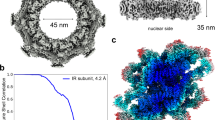Abstract
The vertebrate Tap protein is a member of the NXF family of shuttling transport receptors for nuclear export of mRNA. Tap has a modular structure, and its most C-terminal domain is important for binding to FG repeat-containing nuclear pore proteins (FG-nucleoporins) and is sufficient to mediate nuclear shuttling. We report the solution structure of this C-terminal domain, which is based on a distinctive arrangement of four α-helices and is joined to the next module by a flexible 12-residue Pro-rich linker. F617A Tap suppresses FG-nucleoporin binding by the most C-terminal domain that, together with the structure of the other modules from which Tap is constructed, provides a structural context for its nuclear shuttling function.
This is a preview of subscription content, access via your institution
Access options
Subscribe to this journal
Receive 12 print issues and online access
$189.00 per year
only $15.75 per issue
Buy this article
- Purchase on Springer Link
- Instant access to full article PDF
Prices may be subject to local taxes which are calculated during checkout




Similar content being viewed by others
References
Cullen, B.R. Mol. Cell. Biol. 20, 4181–4187 (2000).
Ryan, K.J. & Wente, S. Curr. Opin. Cell Biol. 12, 361–371 (2001).
Stewart, M. et al. FEBS Lett. 498, 145–149 (2001).
Damelin, M. & Silver, P.A. Mol. Cell 5, 133–140 (2000).
Rout, M.P. et al. J. Cell Biol. 148, 635–652 (2000).
Ribbeck, K. & Görlich, D. EMBO J. 20, 1320–1330 (2001).
Segref, A. et al. EMBO J. 16, 3256–3271 (1997).
Herold, A. et al. Mol. Cell. Biol. 20, 8996–9008 (2000).
Tan, W., Zolotukhin, A.S., Bear, J., Patenaude, D.J. & Feldber, B.K. RNA 6, 1762–1772 (2000).
Braun, I.C., Herold, A., Rode, M., Conti, E. & Izaurralde, E. J. Biol. Chem. 276, 20536–20543 (2001).
Strässer, K., Bassler, J. & Hurt, E. J. Cell Biol. 150, 695–706 (2000).
Weingand, H.L. et al. Mol. Cell. Biol. 22, 245–256 (2002).
Levesque, L. et al. J. Biol. Chem. 276, 44953–44962 (2001).
Katahira, J. et al. EMBO J. 18, 2593–2609 (1999).
Kang, Y. & Cullen, B.R. Genes Dev. 13, 1126–1139 (1999).
Liker, E., Fernandez, E., Izaurralde, E. & Conti, E. EMBO J. 19, 5587–5598 (2000).
Fribourg, S., Braun, I.C., Izaurralde, E. & Conti, E. Mol. Cell 8, 645–656 (2001).
Schmitt, I. & Gerace, L. J. Biol. Chem. 276, 42355–42363 (2001).
Bachi, A. et al. RNA 6, 136–158 (2000).
Kang, Y., Bogerd, H.P. & Cullen, B.R. J. Virol. 74, 5863–5871 (2000).
Suyama, M. et al. EMBO Rep. 1, 53–58 (2000).
Clarkson, W.D., Kent, H.M. & Stewart, M. J. Mol. Biol. 263, 517–524 (1996).
Withers-Ward, E.S. et al. Biochemistry 39, 14103–14112 (2000).
Bayliss, R. et al. J. Mol. Biol. 293, 579–593 (1999).
Bayliss, R., Littlewood, T.D. & Stewart, M. Cell 102, 99–108 (2000).
Wüthrich, K. NMR of proteins and nucleic acids (John Wiley, New York; 1986).
Hommel, U., Harvey, T.S., Driscoll, P.C. & Campbell, I.D. J. Mol. Biol. 227, 271–282 (1992).
Nilges, M. J. Mol. Biol. 245, 645–660 (1995).
Nilges, M., Gronenborn, A.M., Brünger, A.T. & Clore, G.M. Protein Eng. 2, 27–38 (1988).
Brünger, A.T. X-PLOR Version 3.1(Yale University, New Haven; 1992).
Diamond, R. Acta Crystallogr. D 51, 127–135 (1995).
Acknowledgements
We are grateful to our colleagues in Cambridge and Heidelberg, especially R. Bayliss, T. Littlewood, K. Strässer and A. Weeds for their helpful comments and criticisms. We thank J.C. Yang for help in recording NMR spectra, S. Peak-Chew for N-terminal sequencing and mass spectroscopy, and G. Wong for preparing proteins. Supported in part by the Human Frontiers Science Program.
Author information
Authors and Affiliations
Corresponding author
Ethics declarations
Competing interests
The authors declare no competing financial interests.
Rights and permissions
About this article
Cite this article
Grant, R., Hurt, E., Neuhaus, D. et al. Structure of the C-terminal FG-nucleoporin binding domain of Tap/NXF1. Nat Struct Mol Biol 9, 247–251 (2002). https://doi.org/10.1038/nsb773
Received:
Accepted:
Published:
Issue Date:
DOI: https://doi.org/10.1038/nsb773
This article is cited by
-
The nascent RNA binding complex SFiNX licenses piRNA-guided heterochromatin formation
Nature Structural & Molecular Biology (2019)
-
The coming-of-age of nucleocytoplasmic transport in motor neuron disease and neurodegeneration
Cellular and Molecular Life Sciences (2019)
-
Export of piRNA precursors by EJC triggers assembly of cytoplasmic Yb-body in Drosophila
Nature Communications (2016)
-
Control of mammalian gene expression by selective mRNA export
Nature Reviews Molecular Cell Biology (2015)
-
TREX exposes the RNA-binding domain of Nxf1 to enable mRNA export
Nature Communications (2012)



